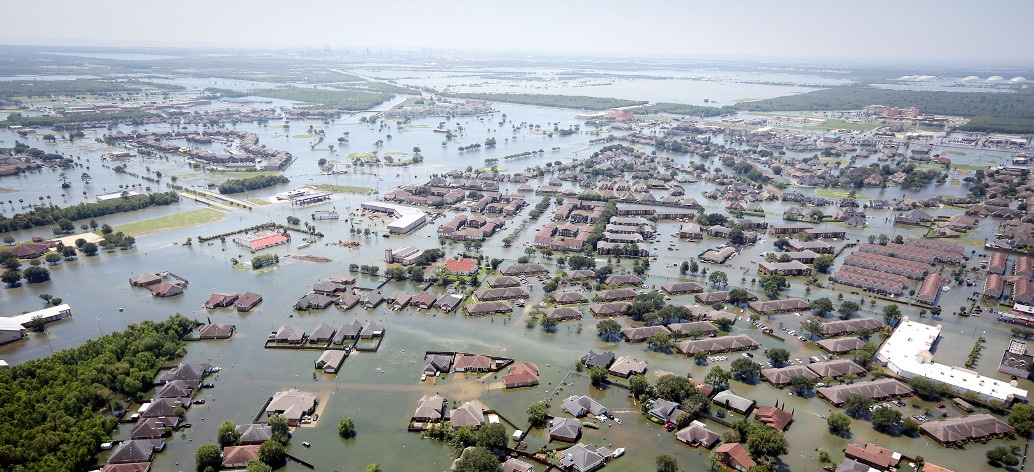Designing resilient solar projects to withstand catastrophic flooding events is a delicate balance to manage. Designs must meet or exceed code requirements, maintain structural integrity when facing extreme flood events and minimize both project capital costs and operating expenses. A well-balanced project design is one that maximizes use of the buildable space for a parcel of land while avoiding costly impacts from flood damage during the operational period. The latter can be achieved by constructing solar arrays outside of expected flood areas or incorporating a structural design with adequate freeboard and structural strength to survive extreme flood events.
The 100-year flood is the common benchmark, or design flood, that engineers consider when determining solar array layouts and structural member sizes. This extreme event is defined as a flood that has a 1 in 100 chance of being equaled or exceeded in any given year. There is both statistical and anecdotal evidence supporting the claim that today’s extreme flood events are more severe (i.e., greater depths, extents, and velocities) and more frequent than historical averages. This is illustrated statistically in the chart shown below. This figure shows an increasing percentage of land area across the contiguous United States where a greater than normal portion of total annual precipitation has come from extreme single-day events.

While extreme precipitation events appear to be occurring more frequently over time, the design requirements for flood protection have not become stricter to account for these changing conditions. If flood protection design requirements do not evolve in parallel to a changing climate, solar projects may see a higher rate of flood damage than expected during their 25-to-40-year lifespan.
Flooding impact on renewables
The impact flooding can have on solar projects is highlighted in the photo below. In addition to potentially negative impacts to structural and electrical components at solar projects, issues related to erosion control can occur. Accounting for flooding appropriately in the design of a solar projects is important to avoid increased downtime, increased equipment repair costs, and negative impacts to environmentally sensitive habitats.

- Site access
Solar facilities typically contain dirt or gravel roads to access important locations such as module blocks, electrical enclosures, and meteorological stations. Even minor flooding can erode or block off access roads at a solar site, preventing operations personnel from working on equipment that needs attention which can result in increased downtime. Sites that are topographically complex or contain cohesive soils that drain poorly are at an elevated risk to access issues resulting from erosion or extended periods of standing water.
- Structural failures
Floods have the potential to damage structural racking framing and modules, particularly in locations where high flow velocities are expected during a flood event. Debris can be carried by moving water and these objects can impact and cause structural failure of racking members and modules. Conventional racking framing includes driven steel piles. Flowing water at the pile to soil interface can cause scour of the soil at the base of racking piles, effectively reducing the pile’s embedment and load carrying capacity.
- Environmental damage
Environmentally sensitive habitats such as wetlands are often located nearby or within solar project boundaries. These environments can be degraded by sediment and contaminant transported from their watersheds during flood events. Solar projects are often obligated to comply with strict permitting requirements intended to prevent wetland and habitat impacts. Flooding at a project elevates the risk of unauthorized sediment or contaminant transport which could result in permit non-compliance issues.
- Electrical equipment damage
Solar facilities contain a wide array of electrical equipment and conductors. Many of these components have ingress protection ratings but are typically not designed to be submersible. Prolonged exposure to water, especially in submersion, can result in damaged electrical equipment which needs replacing.
Flood risk mitigation
Appropriate attention to flood risk mitigation measures during the development and construction of a solar project can prevent negative impacts. Accurate estimation of flooding conditions plays a key role in equipment layout and design specification requirements to minimize repair costs and project downtime. Some of the main design considerations for addressing flood risk at a project are summarized below.
- Flood studies
Civil consultants can perform site-specific flood studies, often referred to as hydrology studies, to determine anticipated flood extents, depths, and velocities associated with different scenarios. These studies are typically more accurate and include more information than the publicly available Federal Emergency Management Agency (FEMA) Flood Insurance Rate Maps (FIRMs) commonly used as a basis of design for solar projects. A flood study is a key data source for informing civil, structural, and electrical design details.
- Civil design
Civil drawings are prepared for solar projects to specify drainage and erosion control design requirements. It is important that civil drawings include specifications on the use of established best management practices (BMPs), such as silt fences, runoff diversions, or stream buffers to prevent negative erosion impacts to the surrounding environment. In addition to erosion control requirements, civil design drawings also specify design details for stormwater control features at a site. This can include the location and size of low water crossings, culverts, stormwater basins, and channels. The civil drawings also show grading details across a project which impacts the flow of water at a site. Both erosion control and stormwater design details can be informed by hydrology study findings. An accurate estimation of flooding conditions can result in properly placed and sized civil design details and reduce the risk associated with flooding.
- Structural design
Structural drawings are prepared for solar projects to show tracker and racking design requirements. Structural design consideration for tracker stow, equipment freeboard, and pile scour protection are important to mitigate flood risk at solar projects. If flooding is expected within the solar array footprint at a project, trackers can be programmed or manually operated to rotate into a “flood stow” position. This is a position parallel, or close to parallel, with the ground which allows flowing water to avoid impacting modules and reduces the risk of module damage during a flood. Fixed tilt racking systems can be designed to provide a minimum “freeboard” or gap between the bottom edge of modules and estimated flood water surface elevation. Water contact with foundations during a flood event may be unavoidable, therefore piles can be armored with rip-rap to reduce the energy of flowing water and prevent washout of material around piles. Alternatively, scour depth can be estimated in a hydrology study and a specific depth of soil around piles can be neglected in the structural calculations to ensure piles have adequate structural capacity in the event of erosion. Improper protection and layout of solar project equipment can result in short circuits or damage requiring replacement.

Chad Homuth is principal engineer at Natural Power, an independent consultancy and service provider that supports a global client base in the effective delivery of a wide range of renewable projects including onshore wind, solar, renewable heat, energy storage, hydrogen and offshore technologies.
The views and opinions expressed in this article are the author’s own, and do not necessarily reflect those held by pv magazine.
This content is protected by copyright and may not be reused. If you want to cooperate with us and would like to reuse some of our content, please contact: editors@pv-magazine.com.








By submitting this form you agree to pv magazine using your data for the purposes of publishing your comment.
Your personal data will only be disclosed or otherwise transmitted to third parties for the purposes of spam filtering or if this is necessary for technical maintenance of the website. Any other transfer to third parties will not take place unless this is justified on the basis of applicable data protection regulations or if pv magazine is legally obliged to do so.
You may revoke this consent at any time with effect for the future, in which case your personal data will be deleted immediately. Otherwise, your data will be deleted if pv magazine has processed your request or the purpose of data storage is fulfilled.
Further information on data privacy can be found in our Data Protection Policy.